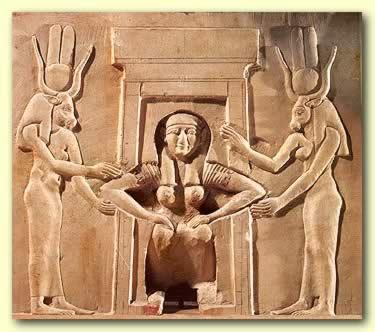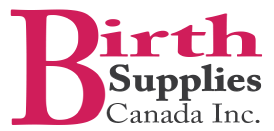Blog
A More Accurate Nativity Scene

I like this painting. It reminds me of a rather typical home birth scenario: we have the mother, no doubt exhausted, resting on a crimson mat (these were the days before blue chux pads, after all), while the midwife examines the new born, and her maidservant (literally her doula) cleans up, and draws water for either cleaning up the mother, or bathing the newborn, or something of that nature. The father looks on, perhaps in shock, disbelief, or awe at the miracle that has just taken place.
While the canonized Bible is silent about the exact details regarding the birth of Jesus, there are early Christian writings and lore that speak of two women (sometimes referred to by the names Salome and Sarah) being the first people (other than Mary) to witness the infant Jesus. This tradition was carried up through both the Western and Eastern Churches, as there are pieces like this painted by both Orthodox and Italian artists, even into the early Renaissance period. This painting is very accurate, when put in the cultural context of the birth of Jesus.
Birth was an event that was restricted to women. Unlike many modern renditions of the Nativity, Joseph would not have delivered Jesus, and was most likely not even present to witness it. Mary is cleaned up and resting, while the women attend to the details of the birth process. Joseph keeps to the side, and likely just entered the room. He would not have been present for the delivery of the afterbirth, and would have waited outside until his betrothed was all tidied up. According to Hebrew tradition, Mary would have been regarded as unclean, due to the fact that she was bleeding. Joseph was forbidden to even touch her.
Whether Mary laboured in the presence of a midwife, or whether the midwife arrived just moments too late, is a debated issue among scholars of early Christian writings. One can only imagine the strength that Mary had as young teen to be labouring unsupported as Joseph frantically sought out a midwife at night in a city that was not their home – this after enduring a donkey ride of several days to travel there. The face of a wise woman would have been very comforting as she groaned and swayed through her labour. I’m sure that the presence of other women either at or immediately after the birth, would have been much more valuable to Mary than any amount of gold, frankincense, or myrrh.
So forget the shepherds. Forget the Magi. It was the birth attendants who were so blessed as to be the first witnesses to the life of Jesus. It really is a story of redemption, as women would have fallen even farther down than shepherds on the social scale. However, women were given the honour that night – not for their wealth or social standing – but for their strong hands, their strong presence, and their strong faith in the ability of a teenage girl to give birth. This is what I will remember every time I drive past a Nativity display.
So whether you observe the holidays by gazing at a tree, a log, a menorah, a wreath, the fireplace channel, or a suckling newborn, may you find joy and peace (salome) this holiday season.
- Jill and Paul Colpitts
Waterbirth - for the spirit

Giving birth in water just makes sense to me.
I did my BA in religious studies, and over and over again I saw water as a reoccurring theme in religions and cultures throughout the world. For the Ancients, water was often viewed as a symbol of both chaos and fertility. Christians are not the only group that uses baptism as a rite of rebirth and cleansing. Many Jewish groups baptize as a rite of conversion and purification. Hindus find spiritual significance in bathing in the sacred Ganges. In Islam, washing is deemed necessary before entering a Holy site, and special fountains are usually situated in front of the entrance for that purpose. Nobility practiced water birth in ancient Egypt, and it was thought that a baby born in water would one day become a priest or priestess.
So how does this relate to birth in our time and context? Well, first of all, whether a person is “religious” or not, the birth of a child is a significantly spiritual event in a family. Even if people don’t realize it, becoming a parent changes a person on a spiritual level. It changes the way they think, live their lives, and view the world. Children instill a sense of meaning and purpose in our lives, and give us a vested interest in the future. Childbearing and parenthood teaches people about love, giving, and sacrifice. Is this starting to sound familiar?
It makes sense then that water be used either symbolically or physically as a vessel for childbirth. My daughter was born in the water right on the cusp of the Greek zodiac signs Aquarius and Pisces – a true water baby. While I am not a follower of astrology, I can’t help but believe that she was holding out for that birthday. She was 9 days overdue, and I had been begging and pleading with her to be born for quite some time. Perhaps that day meant something to her, or just to me. I suppose I will never really know. What I do know is on that day I was reborn as a woman. I would never be the same. In my arms I held a new life – a spotless, clean slate of possibility and limitless potential. I had entered the waters of chaos, and emerged from my pool a new person – a mother (and a whole different kind of chaos)!

- Jill and Paul Colpitts
Aboriginal Midwifery in Canada

Since the mid-1980s, there has been a movement to bring birth back to Aboriginal communities, through the training of local midwives, the establishment of birthing centres and the integration of traditional and western practices. This mobilization has developed in response to government policies that have required Aboriginal women to give birth in southern and urban centres for decades, rather than in their own homes and communities.
In this 20 minute documentary, First Nations, Inuit and Métis midwives and representatives from Aboriginal organizations discuss the challenges, benefits and significance of Aboriginal women taking control of this most sacred ceremony and bringing it back home.
To hear the Pod cast visit the NAHO/The National Aboriginal Health Organization.
- Nikiah Seeds
Ancient Egyptian Midwifery and Childbirth
In ancient Egypt there were no known words for midwife, obstetrician, or gynecologist. But because ancient Egyptians did not have words for these things does not mean that they did not exist. In Ancient Egypt the midwife came in many forms. For peasants the midwife was a friend, neighbor, and/or family member who helped deliver the baby. For noblewomen and wealthier classes the midwife was usually a maidservant or nurse who already lived in the household. Midwives at this time did not have formal training to learn their trade. Instead they learned by apprenticeships where the knowledge was passed down from family member to family member or from friend to friend. The work of the midwife included providing emotional support, encouragement, medical care, and religious help and protection to women during their lives. The areas that midwives focused on were pregnancy, labor, fertility, and contraception.

Most ancient Egyptian women labored and delivered their babies on the �cool roof of the house or in an arbor or confinement pavilion, which was a structure of papyrus-stalk columns decorated with vines� (Parsons p. 2). In Ptolemaic times, women from the noble class gave birth in birth houses that were attached to temples. The positions that these women took when they delivered their babies were standing, kneeling, squatting, or sitting on their heels on birthing bricks, or sitting on a birthing chair. The midwife would then be positioned in front of the mother to help the delivery and catch the baby. Two other women or midwives would be placed on either side of the mother to hold her hands and arms while she was pushing and to give encouragement. Sometimes the midwife would place a dish of hot water under the birthing chair so that steam could help ease delivery. The birthing bricks that ancient Egyptian women used were 14 by 7 inches long and decorated with colorful painted scenes and figures of the birth process. Birthing chairs were made of brick and had a hole in the center. They were decorated with hieroglyphic inscriptions of the owner and painted scenes of the mother, baby, and goddesses.
Since birth and delivery could be dangerous for both the mother and child, ancient Egyptian midwives used many goddesses and gods for help and protection. Goddesses and gods which ancient Egyptian midwives and women thought would help during pregnancy and birth were Hathor, Bes, Taweret, Meskhenet, Khnum, Thoth, and Amun. Hathor was the guardian-goddess of women and domestic bliss and watched over women giving birth. She took the shape of a cow. Bes was a dwarf-goddess who vanquished any evil things hovering around the mother and baby. Taweret was the pregnant hippopotamus-goddess and the chief deity of women during pregnancy, childbirth, and breastfeeding. She carried a magic knife or the knot of Isis. Meskhenet was depicted in the shape of a birthing brick with a human head and gave strength and support to the laboring mother. Khnum was the creator-god who gave health to newborn babies after birth. The god Thoth helped the delivery along and the god Amun helped sooth severe labor pains by blowing in a cool northern breeze (Parsons, p. 3). Statues and pictures of these goddesses and gods were placed throughout room and painted on the walls, birthing bricks and chairs that the laboring women used. Another way that midwives called on divine help and protection during labor was to �place a magic ivory crescent-shaped wand, decorated with carvings of deities, snakes, lions, and crocodiles, on the stomach of the women giving birth� (Parsons, p. 3).
On the Ebers, Kahun, Berlin, and Carlsberg papyri there are many tests and methods described for fertility, pregnancy, and contraception that ancient Egyptian midwives and women used.
Birth Control:
-Silphium, honey, and natron used for their contraceptive properties.
-Soak cotton in a paste of dates and acacia bark and insert into vagina.
-Acacia, carob, dates, all to be ground with honey and placed in the vagina.
Fertility Treatment:
-A woman should squat over a hot mixture of frankincense, oil, dates, and beer and allow the vapors to enter her.
Pregnancy Tests:
-Emmer and barley seeds, the lady should moisten with her urine every day, like dates, and like sand in two bags. If they all grow, she will bear a child. If the barley grows it will be a male, if the emmer grows it will be a female, if neither grow she will not bear a child.
-Examine the blood vessels over the breasts. Smear the breasts, arms, and shoulders with new oil. Early in the morning if her blood vessels look fresh and good, bearing children will occur. If the vessels are green and dark, she will bear children late.
-Give a women milk from one who had already borne a male child mixed with melon puree. If it made the women sick she was pregnant.
Induce Delivery:
-Place on the woman’s abdomen a plaster of sea salt, emmer wheat, and rushes from the Nile River.
Contracting the Uterus:
-Mix the kheper-wer plant, honey, water of carob, and milk. Strain and place in the vagina.
Spells to Assist the Birth Process:
Come down, placenta, come down! I am Horus who conjures in order that she who is giving birth becomes better than she was, as if she was already delivered…Look, Hathor will lay her hand on her with an amulet of health! I am Horus who saves her!� Repeat four times over a Bes-amulet, placed on the brow of the woman in labor.
Make the heart of the deliverer strong, and keep alive the one that is coming.�
References:
Permission for the re-printing of this article came from Emily Hildebrant, EMuseum Manager.
Thank you Emily!
Archaeologists uncover 3700-year-old `magical’ birth brick in Egypt. Eurekalert http://www.eurekalert.org/pub_releases/2002-07/uop-au3072502.php 30 Nov. 2002.
Parsons, Marie. �Childbirth and Children in Ancient Egypt. Tour Egypt http://www.touregypt.net/featurestories/mothers.htm 30 Nov. 2002.
Ancient childbirth seat found in Egypt. Blueyonder http://www.ancienthistory.pwp.blueyonder.co.uk/enter/news/272.htmlhttp 04 Nov. 2002.
Women’s Health and Obstetrics in Ancient Egypt.
Geocities http://www.geocities.com/honda841/Egypt.html 04 Nov. 2002.
Health�Egyptian Approach to Illness, Pregnancy and Childbirth. Members http://members.rogers.com/jasthompson/healthinegypt.htm 04 Nov. 2002.
Ancient Egypt: Medicine-Pregnancy and childbirth. Reshafim http://www.reshafim.org.il/ad.egypt/timelines.topics/medicine.htm
Written by Alison Thiele, 2002
- Sue MacGregor
Pinard Making
Well we did it!
We have been officially up and running since January and are happy to be here and running the midwifery shop and birth shop together all at once!
I really do love the traditional aspect of midwifery, so it just feels right to have someone I know making some of the products I am able to carry in the shop for the midwifery community.
As of late I have been having many inquirys about our Pinard horns and Birthing stools so I thought it would be fun to post an image of Arnold the wonderful man who makes them for us in action!![]()
![]()
- Nikiah Seeds
January 1st, 2008
It is the New Year and I am excited to being “this close” to launching this new web-site!
With a few more products and tweaks, I think we will be all set for a launch on the 15th!
Happy new Year Mama Goddess!![]()
- Nikiah Seeds




